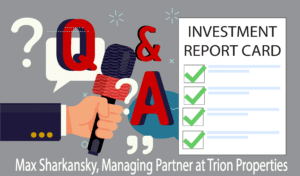
In the previous phase of the market cycle, it felt like a rising tide was lifting all boats—but today’s environment is a different story. As multifamily investors face elevated and volatile interest rates, shifting rental growth trends, and a slowdown in transaction volume, a thoughtful investment process is more important than ever.
Five topical questions were posed to Max Sharkansky, Managing Partner at Trion Properties. Check out what he had to say about current market conditions—including stress in the banking sector and recession risks—and how Trion Properties is positioning for success.
Q. How are recession fears and interest rate dynamics affecting your approach to this market?
Overall, we’re taking a disciplined, conservative approach—but we’re not relegating ourselves to the sidelines. The primary theme for us is “normalization.” We aren’t seeing much softening of rents in our markets, NOIs are holding strong, and underlying fundamentals are quite healthy. We’re modeling rental growth rates of about 3% to 4% annually. This is a slower pace than the red-hot levels seen during the previous phase of the cycle, but they are in line with the long-term normal, and we believe there is plenty of opportunity for attractive investments at these levels.
In terms of interest rates, we have a few properties in our portfolio with floating-rate debt, expiring rate caps, and maturities this year—but it’s not as ominous as it sounds. Our properties with higher rate cap reserves and maturing loans were purchased in 2020 and 2021, so the NOIs and values are significantly higher than at acquisition, giving us ample cushion to refinance or sell. If any of the assets with floating-rate debt do not sell, we can refinance with fixed-rate debt.
Our operational goal for 2023 is to recover occupancy levels at or close to those of 2022, unlike other years where the goal has been to drive rents post-renovation—even if it meant holding occupancy levels slightly below market. Focusing on occupancy will allow us to preserve as much cash flow as possible through this period of high rates on floating-rate loans.
Q. How is stress in the banking system affecting your portfolio?
First, I’d like to be clear that we are confident in our current banking relationships. We have carefully reviewed liquidity and solvency metrics for the banks where we hold cash deposits. In our judgment, the risks to our business and to our investors are adequately managed. We also feel confident about our lenders. We will continue to monitor the situation on both fronts.
The acute turbulence in the banking sector seems to be stabilizing as the government promptly stepped in with powerful policy measures. We see the issues that brought down Silicon Valley Bank and Signature Bank as relatively isolated problems; at this point, we don’t believe we’re facing a systemic threat that will knock down all the dominoes like the global financial crisis did.
The Federal Reserve is expected to take a softer approach to rate hikes as the banking situation plays out and inflation continues to ease—this feels like a silver lining. While interest rates aren’t exceedingly high from a historical perspective, the pace at which they have climbed has certainly been a shock to the system. A breather would be welcomed and could provide relief in acquisition financing and refinancing.
Q. In terms of multifamily transaction activity, what are you seeing?
Higher interest rates, tighter credit standards, and macroeconomic uncertainty—intensified by the recent banking sector issues—have curtailed transaction activity.
That said, we’ve been able to draw on our strong industry relationships to continue arranging off-market opportunities and acquiring assets at discounted purchase prices. In fact, 2022 was a record-breaking year for us in acquisitions. We added 11 new properties through nine transactions with a total acquisition value of more than $489 million. We have three properties currently on the market, all of which will be sold at a profit, and expect to list at least two more for sale this year.
The treasury market rally brought down rates on fixed-rate debt and we are now seeing loan quotes for 5-year money in the mid-5% range. The opportunity to acquire 5% caps with upside financed by 5.5% debt will certainly bring several investors back in from the sidelines and spur some activity.
We continue to be on the lookout for new opportunities. There are always sellers who are highly transactional, or need to sell for internal reasons and are willing to meet the demands of a changing market.
Q. Which geographic areas are you targeting right now and why?
Trion’s investment philosophy is to target select geographic markets where we can successfully operate throughout the real estate cycle—not just when times are good. We look for sustainable growth supported by a diverse set of strong economic drivers and favorable supply-demand dynamics. Specifically, we target assets in supply-constrained, high-growth markets.
Right now, the current trends in Denver, the Pacific Northwest, and Southeastern U.S. are presenting us with favorable opportunities. Last September, for example, we purchased a three-property portfolio in the Portland, Oregon submarket of Beaverton. The assets are situated in prime locations with direct access to public transportation, shopping, and entertainment. The region continues to attract high-caliber residents thanks to its excellent quality of life and rapid job growth driven by premier technology companies.
Q. How are you managing insurance costs, especially with exposure in the Florida market?
Rising insurance costs are challenging commercial property owners nationwide and are particularly difficult in Florida and other areas that experience frequent weather-related catastrophes. Inflation isn’t helping, either. Insurance is a material operating expense, so we pay close attention to market conditions and pencil expected premium increases into our models. We also work to benefit from economies of scale and from thorough, documented risk management plans.

